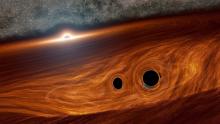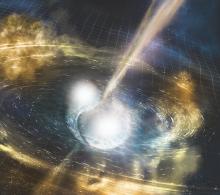Listen to today's episode of StarDate on the web the same day it airs in high-quality streaming audio without any extra ads or announcements. Choose a $8 one-month pass, or listen every day for a year for just $30.
You are here
LIGO II
In late 2011, physicist Rainer Weiss was checking out an instrument in Washington state that he’d helped create. It was one of two sites of LIGO — an observatory designed to “listen” for gravitational waves — tiny ripples in space-time. The project was in its early stages, and Weiss was pondering what it might find.
Weiss got what he asked for, and not just once. As of the end of last year, scientists had reported the discovery of 10 sets of merging black holes. The discoveries confirmed one of the predictions in Albert Einstein’s theory of gravity — and helped earn Weiss a share of the 2017 Nobel Prize in Physics.
Detailed analysis of the waves revealed the distances to the black holes. They also revealed the masses of the black holes, both before and after they merged. The heaviest merged black hole was about 80 times the mass of the Sun.
And scientists could be hearing the “chirp” of merging black holes more often in the future. LIGO is scheduled to return to work this month after an upgrade. It’s also working with a European project, called VIRGO. That should make it possible to detect merging black holes that are farther away. It could also allow the observatories to detect other sources of the waves — more ripples in the universe.
Script by Damond Benningfield






